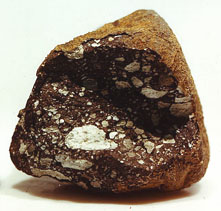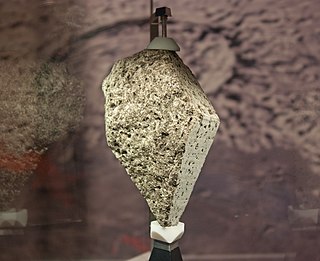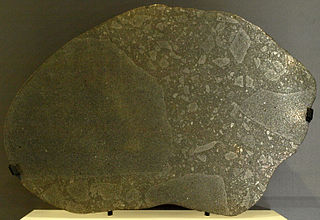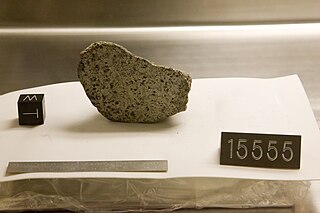
A meteorite is a rock that originated in outer space and has fallen to the surface of a planet or moon. When the original object enters the atmosphere, various factors such as friction, pressure, and chemical interactions with the atmospheric gases cause it to heat up and radiate energy. It then becomes a meteor and forms a fireball, also known as a shooting star; astronomers call the brightest examples "bolides". Once it settles on the larger body's surface, the meteor becomes a meteorite. Meteorites vary greatly in size. For geologists, a bolide is a meteorite large enough to create an impact crater.

A lunar meteorite is a meteorite that is known to have originated on the Moon. A meteorite hitting the Moon is normally classified as a transient lunar phenomenon.

Campo del Cielo refers to a group of iron meteorites and the area in Argentina where they were found. The site straddles the provinces of Chaco and Santiago del Estero, located 1,000 kilometers (620 mi) north-northwest of Buenos Aires, Argentina and approximately 500 kilometres (310 mi) southwest of Asunción, Paraguay. The crater field covers 18.5 by 3 kilometres and contains at least 26 craters, the largest being 115 by 91 metres.

In southeastern Russia, an iron meteorite fell on the Sikhote-Alin Mountains in 1947. Large iron meteorite falls have been witnessed, and fragments have been recovered, but never before in recorded history has a fall of this magnitude occurred. An estimated 23 tonnes of fragments survived the fiery passage through the atmosphere and reached the Earth.

An achondrite is a stony meteorite that does not contain chondrules. It consists of material similar to terrestrial basalts or plutonic rocks and has been differentiated and reprocessed to a lesser or greater degree due to melting and recrystallization on or within meteorite parent bodies. As a result, achondrites have distinct textures and mineralogies indicative of igneous processes.

Moon rock or lunar rock is rock originating from Earth's Moon. This includes lunar material collected during the course of human exploration of the Moon, and rock that has been ejected naturally from the Moon's surface and landed on Earth as meteorites.

Neumann lines, or Neumann bands, are fine patterns of parallel lines seen in cross-sections of many hexahedrite iron meteorites in the kamacite phase, although they may appear also in octahedrites provided the kamacite phase is about 30 micrometres wide. They can be seen after a polished meteorite cross-section is treated with acid. The lines are indicative of a shock-induced deformation of the kamacite crystal, and are thought to be due to impact events on the parent body of the meteorite.

The Fukang meteorite is a meteorite that was found in the mountains near Fukang, China in 2000. It is a pallasite—a type of stony–iron meteorite with olivine crystals. It is estimated to be 4.5 billion years old.

Lunar soil is the fine fraction of lunar regolith found on the surface of the Moon and in the Moon's tenuous atmosphere. Lunar soil differs in its origin and properties significantly from terrestrial soil.

The Peekskill meteorite is among the most historic meteorite events on record. Sixteen separate video recordings document the meteorite burning through the Earth's atmosphere in October 1992, whereupon it struck a parked car in Peekskill, New York, United States. The Peekskill meteorite is an H6 monomict breccia; its filigreed texture is the result of the shocking and heating following the impact of two asteroids in outer space. The meteorite is of the stony variety and approximately 20% of its mass is tiny flakes of nickel-iron. When it struck Earth, the meteorite weighed 27.7 pounds (12.6 kg) and measured one foot in diameter. The Peekskill meteorite is estimated to be 4.4 billion years old.

Enstatite chondrites are a rare form of meteorite, rich in the mineral enstatite. Only about 200 E-Type chondrites are currently known, comprising about 2% of the chondrites that fall on Earth. There are two main subtypes: EH and EL, classified based on their iron content.

Of the 270 Apollo 11 Moon rocks and the Apollo 17 Goodwill Moon Rocks that were given to the nations of the world by the Nixon Administration, approximately 180 are unaccounted for. Many of these rocks that are accounted for have been locked away in storage for decades. The location of the rocks has been tracked by researchers and hobbyists because of their rarity and the difficulty of obtaining more. Moon rocks have been subjects of theft and forgery as well.

Planetary science is the scientific study of planets, celestial bodies and planetary systems and the processes of their formation. It studies objects ranging in size from micrometeoroids to gas giants, aiming to determine their composition, dynamics, formation, interrelations and history. It is a strongly interdisciplinary field, which originally grew from astronomy and Earth science, and now incorporates many disciplines, including planetary geology, cosmochemistry, atmospheric science, physics, oceanography, hydrology, theoretical planetary science, glaciology, and exoplanetology. Allied disciplines include space physics, when concerned with the effects of the Sun on the bodies of the Solar System, and astrobiology.

The Lunar Sample Laboratory Facility (LSLF) is a repository and laboratory facility at NASA's Lyndon B. Johnson Space Center in Houston, Texas, opened in 1979 to house geologic samples returned from the Moon by the Apollo program missions to the lunar surface between 1969 and 1972. The facility preserves most of the 382 kilograms (842 lb) of lunar material returned over the course of Apollo program and other extraterrestrial samples, along with associated data records. It also contains laboratories for processing and studying the samples without contamination.

Joseph Richard Gutheinz is an American attorney, college instructor, commissioner, writer, and former Army intelligence officer, Army aviator, and Federal law enforcement officer. He is known as the founder of the "Moon Rock Project" which aims to track down missing Apollo Moon rock samples.

The Honduras lunar sample displays are two commemorative plaques consisting of small fragments of Moon specimen brought back with the Apollo 11 and Apollo 17 lunar missions and given in the 1970s to the people of Honduras by United States President Richard Nixon as goodwill gifts.

Allan Hills A81005 or ALH A81005 was the first lunar meteorite found on Earth. It was found in 1982 in the Allan Hills at the end of the Transantarctic Mountains, during a meteorite gathering expedition (ANSMET).

Geoffrey Notkin is an American actor, author, and entrepreneur. Notkin is known as one of the hosts of Meteorite Men, a documentary reality television series from Science Channel, which ran for three seasons. He is the president of the National Space Society, and holds a seat on the National Space Society Board of Governors. He is a long-time member of The Explorer's Club. In 2013, Notkin's Twitter account was nominated for a Shorty Award, honoring the best in social media. Notkin has also been interviewed on the Today show, Coast to Coast, and NASA Edge TV, and is a regular guest speaker at TusCon, an intimate science fiction, fantasy, and horror convention held annually in Tucson, Arizona.
Project Harvest Moon was a first effort by private individuals to explore and exploit the Moon. Sponsored by the Committee for the Future, "the original space advocacy organization in the NASA era," Harvest Moon would have used a leftover Saturn rocket and lunar module to conduct experiments on the Moon, paid for by the sale of lunar materials retrieved from the Moon's surface. The Committee for the Future was founded and propelled by Barbara Marx Hubbard, daughter of wealthy toy manufacturer Louis Marx. Hubbard received support from retired military officers, former NASA employees, and prominent industrialists. On May 11, 1972, Rep. Olin Teague (D-Tex) offered a Resolution in support, but the project was terminated that summer following cogent objections from NASA.
Darryl Pitt is an American artist manager, photographer and contributor to the popularization of meteorites.
















